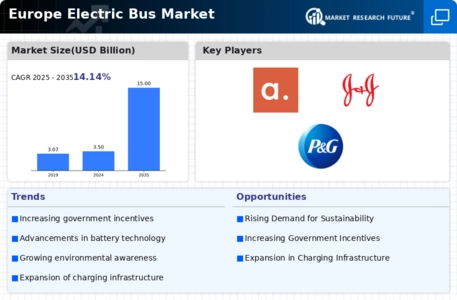Public Health Concerns
Public health concerns related to air quality and noise pollution are increasingly influencing the Europe Electric Bus Market. The adverse effects of diesel emissions on respiratory health have prompted citizens and advocacy groups to demand cleaner alternatives. Electric buses, which operate quietly and produce no tailpipe emissions, are seen as a solution to mitigate these health risks. Recent studies indicate that cities adopting electric buses have reported a noticeable improvement in air quality, leading to enhanced public health outcomes. This growing awareness among the public is likely to drive demand for electric buses, as communities prioritize health and well-being in their transportation choices. The intersection of public health and transportation policy is expected to further accelerate the transition towards electric buses in urban environments.
Environmental Regulations
The increasing stringency of environmental regulations across Europe is a pivotal driver for the Europe Electric Bus Market. Governments are implementing stricter emissions standards to combat air pollution and climate change. For instance, the European Union has set ambitious targets to reduce greenhouse gas emissions by at least 55 percent by 2030. This regulatory landscape compels public transport authorities to transition to electric buses, which produce zero tailpipe emissions. As a result, the market for electric buses is projected to grow significantly, with estimates suggesting a compound annual growth rate of over 20 percent in the coming years. The alignment of public transport policies with environmental goals further reinforces the demand for electric buses, making compliance a key factor in the industry's expansion.
Technological Innovations
Technological advancements play a crucial role in shaping the Europe Electric Bus Market. Innovations in battery technology, such as the development of solid-state batteries, are enhancing the efficiency and range of electric buses. These advancements are not only reducing operational costs but also improving the overall performance of electric buses. Furthermore, the integration of smart technologies, including real-time tracking and predictive maintenance, is streamlining operations for fleet managers. According to recent data, the average range of electric buses has increased to approximately 300 kilometers on a single charge, making them more viable for urban transport. As technology continues to evolve, it is likely that the market will witness a surge in electric bus adoption, driven by improved performance and reduced total cost of ownership.
Economic Incentives and Funding
Economic incentives and funding mechanisms are vital drivers for the Europe Electric Bus Market. Various governments and local authorities are offering financial support to encourage the adoption of electric buses. This includes grants, subsidies, and tax incentives aimed at reducing the initial capital costs associated with purchasing electric buses. For example, the European Union has allocated substantial funds to support the transition to cleaner public transport systems. Reports indicate that funding for electric bus projects has increased by over 30 percent in recent years, reflecting a commitment to sustainable transport. These economic incentives not only lower the financial barriers for public transport operators but also stimulate market growth by making electric buses a more attractive option compared to conventional vehicles.
Urbanization and Population Growth
The rapid urbanization and population growth in European cities are significant drivers for the Europe Electric Bus Market. As urban areas expand, the demand for efficient and sustainable public transportation solutions intensifies. Cities are facing challenges related to traffic congestion and air quality, prompting authorities to seek alternatives to traditional diesel buses. The European Commission estimates that by 2050, over 80 percent of the population will reside in urban areas, necessitating a shift towards electric buses to meet the growing transportation needs. This demographic shift is likely to catalyze investments in electric bus infrastructure, including charging stations and maintenance facilities, further propelling market growth. The alignment of urban planning with sustainable transport solutions indicates a promising future for electric buses in urban settings.

















Leave a Comment